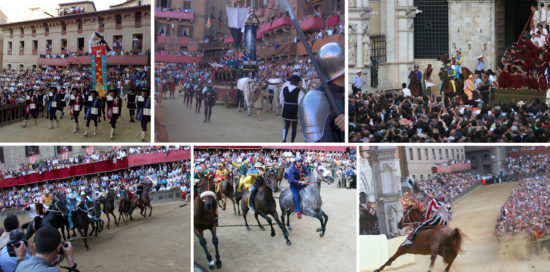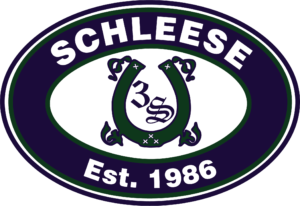Something Different – a Trip Report from Italy (specifically the Palio in Siena)
Jochen and I were just in Italy for a short vacation and travelling through Tuscany on our way to Agropoli on the Amalfi coast where our daughters were attending a dance workshop and performing. Jochen is presently in Germany teaching a refresher saddle ergonomics course, and has asked me to take over this week’s blog for him since he has little time to write anything right now. The format will be a bit different, but hopefully no less informative.
We did a whirlwind tour for about a week and got an introduction to Florence, Pisa, Paestum, Pompei, Rome and Siena. We enjoyed seeing the incredible architecture, the ruins, the artwork and sculptures, but of all the places we visited, we really enjoyed the medieval city of Siena the most. Learning about the connection to horses that Siena has, made it even more significant why this city ‘spoke’ to us the most, so I thought that I would share with you the history of the Palio – an annual event that takes place July 2 and August 16 in the marketplace (Piazza del Campo) of the city.

Siena itself is a city rich with architecturally significant buildings including churches, palaces, and hospitals (Siena was one of the first European cities to have a hospital in 1090), with museums housing the works of artists such as Donatello and Michelangelo. These buildings, along with the narrow streets and the many water fountains work to transport the visitor into the past. We unfortunately were just a couple of days too late to experience the Palio itself, but the history behind it is fascinating.
The two dates are dedicated to the Virgin Mary. The city is divided into 17 districts (used to be more than 50) each with its own territory, population and administration. The district mascots are (funny enough, no horses!): Eagle, Snail, Wave, Panther, Forest, Tortoise, Owl, Unicorn, Shell, Tower, Ram, Caterpillar, Dragon, Giraffe, Porcupine, She-Wolf, and Goose. Much like street signs, you can always recognize which district you are in by the colours and the mascot displayed at each intersection of the narrow cobblestoned streets. The word Palio comes from the Latin, meaning banner, and the Palio is the competition for the honour to display the banner. That’s it – no other honour or cash prize! There are rituals of identity and belonging specific to each district and bringing honour to your own district plays a significant role in whatever you do. Inter-district marriages are as difficult as inter-religious marriages were (or still are in certain places).
On these two days the marketplace is fenced in – an area holding probably ten thousand people – and sand is dumped on the ‘track’ around the middle of the piazza. Only ten horses participate in the Palio – one from each of the districts as chosen: 7 run by right of not having participated on the same date in the previous year, and 3 by luck of the draw. The second race of the year then includes the remaining 7 and 3 by draw again. The horses are also assigned by drawing lots. Once assigned, the districts immediately take their horses into their district stables (which are more luxurious than many homes in the area!) referred to as ‘casa del cavallo’. It’s literally an open space apartment where the groom will live with the horse for the next four days before the event.
The Palio is not a horse race. It is actually war between the districts. The first recorded one on horseback took place in 1656; before that they were run on donkeys and even buffalo. There is only one winner, and no second or third runner up. When one’s district is running, whoever no longer lives in Siena will still return because the district families consider it unthinkable to miss a possible victory. The riding costumes are made in the colours of the district in the most beautiful fabrics and stitched with gold or silver threads.
At around 3 p.m. each district performs a blessing ceremony of its horse and afterwards joins in the large parade in historical costume with over 600 participants, that winds through the city. The armour and weapons worn in the pre-event parade are all real. The parade arrives around 5 p.m. at the Piazza del Campo, and ends by around 6.30-7 p.m. Shortly thereafter the explosion of a firecracker signals the entrance of the horses into the piazza. As the jockeys come out, each one receives a whip made out of ox sinew which they can use to prod their horse or to irritate their opponents. They again draw lots for the order of line up. The first 9 take up their assigned positions in the area between the two ropes, while the last one, the tenth, enters this area at a running gallop thus signaling the start. The horses must run three laps around the piazza, overcoming dangerous points such as a very narrow turn where collisions between the wall and horses have led to many falls in the past (the main reason why many animal activists oppose the Palio).
The first horse that crosses the finish line, even if he arrives without his jockey, wins the race. I’m not really sorry that we missed the actual event this year, because it was brutally hot when we landed (38⁰) and of course high season. Everywhere was crowded and overrun with tourists. I can only imagine what it would have been like to stand in the middle of that crowd (and not really be able to see anything anyway) for what amounts to a 90 second horse race, but this is not to take away from the even itself – which is of such significance to this city. That’s just my personal opinion…but I prefer to stay home during the summer months as a rule in any case – it’s so short up here and there is so little time to enjoy our own backyard! Anyone with me?
